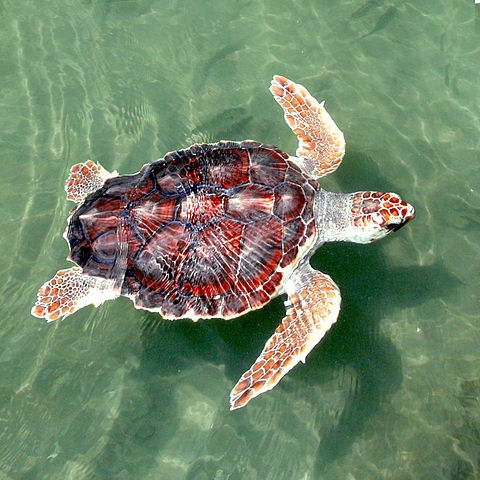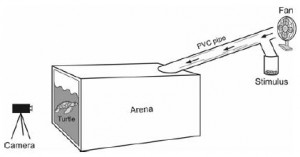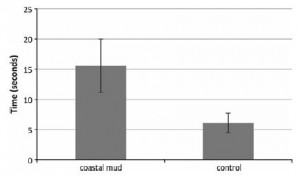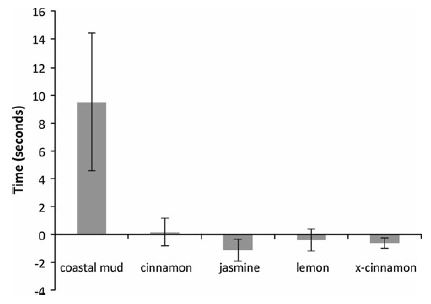Turtles Smell

Loggerhead turtle in Florida, 2011. from U.S. National Oceanographic and Atmospheric Administration.
The paper: Endres, C.S. and Lohmann, K.J. (2013) Detection of coastal mud odors by loggerhead sea turtles: a possible mechanism for sensing nearby land. Marine Biology 160:2951-2956. doi:10.1007/s00227-013-2285-6
Subject areas: Animal Behavior
Vocabulary:
Biomagnetism – some organisms can sense and respond to the earth’s magnetic field (much like a compass). This means that there must be some small bit of magnetic material in the organisms. Tiny amounts of magnetite, a highly magnetic iron oxide, have been found in crystal form in living organisms.
—–
This article is a summary of a recent primary research paper intended for high school teachers to add to their general knowledge of current biology, or to supplement their lessons by showing students the kinds of projects that current biological research addresses.
—–
This paper describes an experiment that, I hope, helps you or your students to recognize that interesting science research does not always require expensive or sophisticated equipment.
As any child who has seen the Disney movie “Finding Nemo” can tell you, sea turtles often travel great distances, far out in the ocean from any land, but eventually returning to their birthplace to reproduce. Although the mechanism the turtles use to accurately find their way over such long treks is not completely understood, the authors of this paper propose that part of the mechanism may include the detection of land by specific odors. Most likely, this would come into play when somewhat close to land, and not out on the open ocean, where it is thought that the Earth’s magnetic field may help to direct the turtles.
 First, Endres and Lohmann wanted to show that the scent of land could alter turtle behavior. Observing loggerhead turtles (Caretta caretta) swimming in a small pool of artificial seawater, the researchers wafted scents through the air across the top of the pool. This simple setup is illustrated in the figure at left. Once the turtles were acclimated to the experimental pool, the fan was turned on, and the turtles were filmed for a period of two minutes beginning with the first time they surfaced to take a breath. The airflow through the main tube picks up odors from the cup of odorant at the T-joint.
First, Endres and Lohmann wanted to show that the scent of land could alter turtle behavior. Observing loggerhead turtles (Caretta caretta) swimming in a small pool of artificial seawater, the researchers wafted scents through the air across the top of the pool. This simple setup is illustrated in the figure at left. Once the turtles were acclimated to the experimental pool, the fan was turned on, and the turtles were filmed for a period of two minutes beginning with the first time they surfaced to take a breath. The airflow through the main tube picks up odors from the cup of odorant at the T-joint.
 Starting with the control condition, an cup of distilled water, the scientists observed that, on average, the turtles would poke their noses above the surface of the water a total of 6.1 seconds in the two minutes recorded (average of ten turtles). They also did the test with coastal mud in the sample cup (taken from Sage Bay, North Carolina, USA). As the figure at right shows, there is a significant increase in the amount of time that the turtles would come up to smell the air, more than doubling to a mean of 15.6 s.
Starting with the control condition, an cup of distilled water, the scientists observed that, on average, the turtles would poke their noses above the surface of the water a total of 6.1 seconds in the two minutes recorded (average of ten turtles). They also did the test with coastal mud in the sample cup (taken from Sage Bay, North Carolina, USA). As the figure at right shows, there is a significant increase in the amount of time that the turtles would come up to smell the air, more than doubling to a mean of 15.6 s.
While those are certainly intriguing and encouraging results, there were still more tests to be done. What if the turtles spent more time just because there was a new scent in the air, and it had nothing to do with finding land? The obvious experiment was to test the turtles reactions to novel odors: the experiments were then repeated using the scents of lemon, jasmine, and cinnamon. The graph below shows the difference in the mean time of at the surface for each odorant as compared to the water control (x-cinnamon is a concentrated cinnamon preparation).
The surface time for coastal mud-scented air is significantly different from the surface time elicited by any of the other odorants tested. As Endres and Lohmann clearly note, this experiment does not address the meaning of the increased surface time, only that the turtles do it. In fact, they suggest an alternate possibility that it could be part of feeding behavior. However, it could be an indication that, in conjunction with a more general direction-finding mechanism like following the earth’s magnetic field, when the turtles get closer to land, the ability to smell it could fine-tune the guidance mechanism.


No comments
Be the first one to leave a comment.